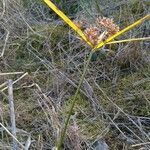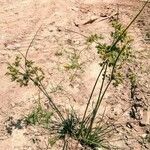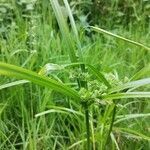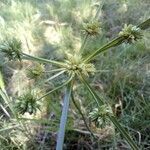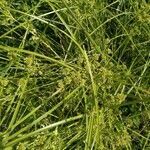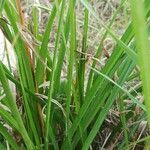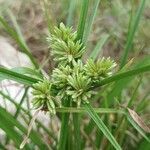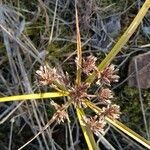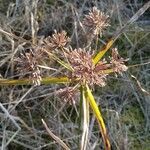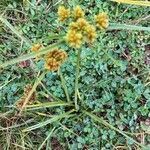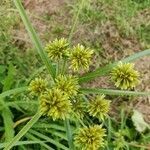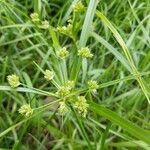Herbs, perennial, cespitose, rhizomatous. Culms trigonous to terete, (25–)40–60(–90) cm, glabrous. Leaves flat or V-shaped, (10–)25–50 cm × 5–8(–12) mm. Inflorescences: heads globose, (10–)20–40 mm diam.; rays (0–)3–10, 2.5–5(–12) cm; 2d order rays usually absent (when present, 0.5–1.5 cm); bracts 4–8, horizontal to ascending at 15–30°, flat (or V-shaped), 3–30(–50) cm × 1.5–8(–12) mm. Spikelets (20–)30–50(–70), oblong, compressed, 5–20 × 2.2–3 mm; floral scales (12–)20–30(–50), off-white to golden brown, basally 2-keeled, laterally ribless, ovate-deltate, 2–2.3 × 1–1.4 mm (declined 30–40º from rachilla). Flowers: stamen 1; anthers 1–1.2 mm; styles 1–1.2 mm; stigmas 0.5 mm. Achenes black or dark brown, stipitate, broadly ellipsoid, 1.2–1.4 × 0.5–0.6 mm, stipe to 0.1 mm, apex apiculate, beak 0.2–0.3 mm, surfaces puncticulate.
Rhizome short, thick, woody. Stems 25-90 cm high, stout, obtusely trigonous, smooth, leafy and ± thickened at base. Leaves usually < stems, 4-8 mm wide, flat, margins finely serrate; sheaths dark purple-brown. Involucral bracts 5-8, leaf like, unequal, often very much > inflorescence. Inflorescence a compound umbel, rather variable in size; rays 5-7-(9), of unequal length, each with a dense pale green to yellow-green globose or hemispherical spike at tip, 1-2 cm diam. Spikelets many, densely crowded, much compressed, ± 5-12 ×3 mm, ovoid-oblong, subacute. Glumes many, ± 2 mm long, densely imbricate, ovate, membranous, cells very distinct, whitish-cream to light brown, 1-distinct lateral nerve on each side, keel green, tip slightly recurved. Stamen 1. Style-branches 3. Nut ± ½ length of glume, trigonous, obovoid brown.
Annual, up to 0.9 m high; tufted, erect, stem 3-angled. Leaf blades flat, keeled, 4-8 mm wide. Flowers: inflorescence of several, rounded, stalked clusters of spikelets radiating from stem apex, overtopped by several, spreading, leaf-like, basal bracts; spikelets digitate, flattened, 2.5-3.0 mm wide; glumes and nutlets abscising individually leaving a persistent rachilla; stamen 1; glumes many, > 2.0 mm long, green or fawn-coloured with greenish and/or reddish markings, when dry, pallid or brown with, or without, greenish or reddish markings Nov.-Apr.
Tufted, erect annual, 250-900 mm tall. Leaf blades flat, keeled, 4-8 mm wide. Stem 3-angled. Inflorescence of several, rounded, stalked clusters of spikelets radiating from stem apex, overtopped by several, spreading, leaf-like basal bracts. Spikelets flattened, 2.5-3 mm wide, light green to golden-brown.
A sedge. It keeps growing from year to year. It has rhizomes. The stems are 40-60 cm tall. They can be 3 angled. The leaves are 25-50 cm long by 5-8 mm wide.
Perennial herb, up to 0.6 m high. Stamen 1. Glumes with a longitudinal, green central zone and a broad band of more delicate semitransparent, green.
Tufted perennial to 1 m. Inflorescence comprising digitate clusters of over 40 spikelets each, green.
